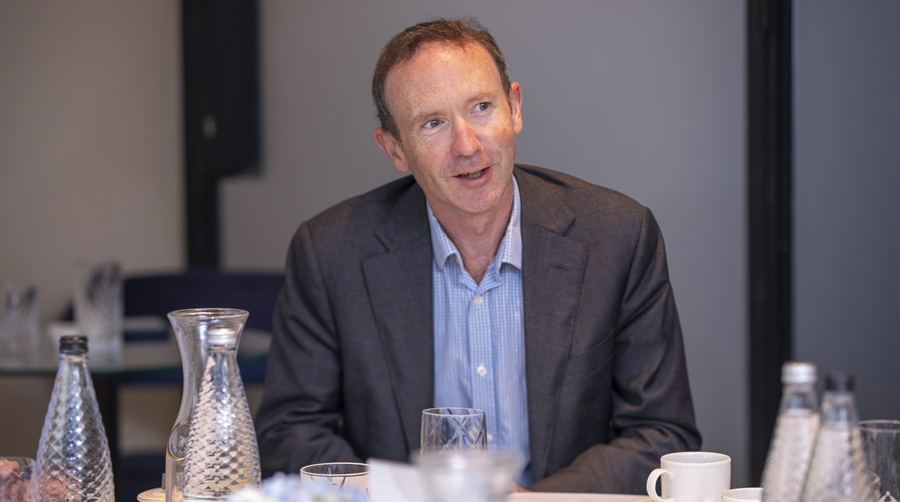
The panellists were (left to right): LCP partner Lydia Fearn; Zedra Governance client director Sam Burden; SEI head of DC for EMEA and Asia Steve Charlton; PP editor Jonathan Stapleton; Columbia Threadneedle Investments institutional business director Andrew Brown; Dean Wetton Advisory managing director Dean Wetton; and Redington head of DC and financial wellbeing Jonathan Parker
In September, Professional Pensions assembled a panel of experts to look at the significant changes in the defined contribution (DC) investment landscape over the past six months.
The roundtable - chaired by PP editor Jonathan Stapleton and held in association with Columbia Threadneedle Investments - discussed the chancellor's Mansion House Reforms, the emergence of long-term asset funds (LTAFs), the new value for money framework and how DC schemes are evolving their investment strategy in light of the changing economic environment.
How ambitious do you think the Mansion House Compact is for DC providers, to allocate 5% of their default funds' assets to unlisted equities by 2030? Do you think DC schemes can and will meet this timescale?
Dean Wetton: There are two issues. The first is the plumbing and whether DC schemes can invest into it, because very few are set up to be able to do so. The National Employment Savings Trust (NEST) is an example that could because it unitises its own assets but many of the others are stuck on unit-linked platforms, which will make it more challenging. The second is whether now is, tactically, the right time to be investing in private equity, when private equity managers are sitting on a pile of spare cash.
Steve Charlton: It will be challenging to get 5% of a large pensions market into a very small asset class - there is not enough private equity to go around. Are we are going to end up with a stack of cash sitting in funds that are performing well? There are costs coming out of those funds as well, in terms of fees. We're looking at 5% of the UK private equity market, not the global private equity markets. The Compact is focused on the UK, which is a very narrow market.
There are nine providers and large schemes signed up to the Compact so far. Are we going to see more schemes follow?
Lydia Fearn: It is a good start. We have been talking about diversifying asset classes within DC strategies for a long time. We have also been talking about what schemes are going to get in these strategies. The way the Compact is worded means it is not mandating, it is providing an aspiration.
We are long-term investors, with members entering in their early 20s and even younger members may be coming up. Having diversification within the growth phase to allow them to benefit from different types of investments is the right thing to do. We need to support their journey towards retirement. Some of the larger schemes can hopefully find solutions that will allow the smaller ones to piggyback.
Jonathan Parker: The costs could still become an issue when it comes to implementing this. Generally, the total fee budget that is available for investment costs within DC remains low, and it is a very competitive market. If you have to put 5% into an asset class that is likely to be more expensive than the asset classes that you currently have in your portfolio, it is going to increase costs. These costs have to be borne by someone, and that is either the members or the sponsor if you are a master trust.
Sam Burden: We have discussed the range of challenges but, on the other hand, six years is quite a long way off.
By 2030, we are also meant to have reduced our carbon emissions by 45%. From a members' point of view, this is something we need to do and we now need to focus on the infrastructure and overcoming the challenges.

Andrew, what did you make of the Mansion House reforms?
Andrew Brown: They are ambitious, certainly in terms of the practicalities. Private equity is still somewhat of a niche asset class with a broad spectrum of potential investments, and when you consider UK venture capital, deal sizes are smaller and even more specialised but require the same level of due diligence. While DC assets have certainly grown and are now meeting the requirement of scale, the governance expertise and resources needed to invest in these types of asset classes, may not be ready to meet the challenges and intricacies of private equity investment.
To what extent do you think the government should be nudging, pushing or mandating this sort of investment?
Lydia Fearn: I don't think it should be. This is the furthest that they have ever gone, and the views within the government may change depending on what happens politically over the coming years. Thinking about a trustee's fiduciary duty and what they are trying to deliver, I don't see how being forced to do something would work.
Sam Burden: You have to take the backdrop into account. The government has already intervened by setting the charge cap level, and that has driven limitations on the range of investments. From the trustee's perspective, you want to make the best decisions on behalf of your members. The government's role is to set a framework without mandating - it requires government to provide a framework for the whole system to work.
The 5% target is a bit too hard-coded. The movement of travel is the important part.
Andrew Brown: The current narrative around private equity investment seemingly centres around boosting returns, a 12% increase in pension lifetime savings. The argument really should be more about diversifying sources of returns and reducing overall risk.
Will DC consolidation pose a challenge for DC allocations to private markets?
Sam Burden: We are going to see more and more schemes and master trusts merge. Hundreds of millions of pounds could be moved from one master trust to another. If private markets are a component of that, it could add considerable complecity.
Andrew Brown: Agreed. The complexity of managing future transitions, whether it is master trusts consolidating or single-employer trusts moving to master trust, is a potential headwind for holding long-term illiquid investments. Consolidation will inevitably lead to suitable scale, however to some degree, we are still on that journey.
To what extent are the various available structures suitable for holding private assets? Are there better alternatives to LTAFs?
Jonathan Parker: The existing legal structures have been around for, in some cases, decades. Defined benefit and other institutional investors have been investing in private equity in several types of vehicles, for example open-ended evergreen funds. These can be used by DC schemes, but some challenges remain. With LTAFs, there is some comfort in having an FCA-regulated regime that the industry has supported.

Lydia Fearn: We are even seeing property funds going into that sort of structure - it has opened the door to innovation. It is good to see them finally, particularly for providing master trusts with access to different types of assets. Saying this, I cannot imagine many single-employer trusts rushing to buy LTAFs - it is likely to only be for scalable schemes.
In another five to ten years, it may be that people feel comfortable with them, but trustees generally want to see how things progress and how things work before investing. Some of the biggest schemes might be prepared to take a bit more of a risk as they have the governance budget to look after this investment.
Dean Wetton: Creating new investment structures is a waste of time, in my opinion. I can see the positive aspects, but it is perfectly possible to put private assets into existing structures.
Andrew Brown: The introduction of LTAFs may provide some impetus and, in some cases, an enabler. Certain master trusts are probably getting there sooner because LTAFs seemingly tackle two major issues - liquidity and holding periods - while providing a fair value price for the underlying asset. However, LTAFs are not necessarily being created for general purpose, and that is why they might lack scale initially. It will be interesting to see how they evolve.
To what extent do you all think the new Value for Money framework will help shift the focus from cost to value? And will this make it easier for DC schemes to include real assets in their portfolios?
Jonathan Parker: We are getting the most positive steer we have ever had from regulators and the government that that the focus should not primarily be on cost.
But it will take some time for real assets to be added. Even if we agree that by allocating an extra ten basis points to our investment budget we could improve members' outcomes by 50-100 basis points, we are some way from seeing a shift in mindset that is going to result in trustees, independent governance committees or pension providers taking that bold step. The framework is sensible in that we are all on an even playing field.
Sam Burden: We always have to remember that it is never the members that look at these things. They never read chair statements or reports. This puts the focus on providers and fiduciaries to raise an independent challenge where it needs to be brought.
The shift from cost to value feels very marginal. The problem is, if you are an employer or a consultancy looking at selecting a new master trust or contract-based scheme, in terms of comparisons, you end up focusing on what you can measure, namely costs and charges. You might accept a bit of variance but it is always there - it is very hard to get away from costs.
Dean Wetton: The consultation hints at collecting asset allocation information and then providing a standardised projection on the basis of that asset allocation. What matters is future performance, not historic, but all we really have to go on is historic.
Steve Charlton: There are still intermediaries out there whose only measure of value for money is how much we are charging, with no other consideration of anything else. Unless we can change that, break that pattern, and find a way of convincing those consultants that are still going on a drive to the bottom that there is actually a different way of looking at it, we will not get there.
Jonathan Parker: You can go into battle for a handful of basis points but not anything more than that. Even if the employer's number one priority for their new pension scheme is having a fantastic digital member experience and communications, if the fees for the provider with the best member experience are any more than a few basis points more than another provider, it becomes really difficult. You need a bold finance director or HR director, or whoever is making that decision within the employer.
Lydia Fearn: One of the problems with the framework is that it is not clear about what it is trying to achieve. We have our own view of what we think it is trying to achieve, but they have not actually said what it is trying to achieve. It is hard to know where we are heading. The second issue is it is not pointed at the right schemes, such as master trusts.

Andrew Brown: There is merit in the value for money framework, partly in promoting a culture shift in how we look at investment returns. The opportunity cost of being in the worst performing master trust, for the same cohort of members, 30 years from retirement, as opposed to being in the best, is significant. There is a surprisingly wide disparity of returns. Value is certainly something that should be appreciated in an investment strategy, assessed net of fees with an understanding of the risk undertaken.
Do you think current DC asset allocations are right for the current environment? If not, do you think the government's arrangements for DC schemes are ripe for a more dynamic approach?
Steve Charlton: Our trustees spend a lot of time making sure they are thinking about what is going on in the world. They are taking views from different advisors before forming their opinions, rather than just relying on a few opinions. The pension funds that are not just focused on equities do have some dynamism to them.
We make strategic asset allocations, but also more dynamic asset allocations. For these, for a small portion, we can shift and change our approach if we see subtle changes in the outlook for a particular market. It is only small, but it allows us to shape the portfolios, particularly for those people who are almost pre-retirement and those that are drawing an income. We are less dynamic for those people that have lots of years, and when we look to 70-year investment horizons we are completely in equities.
Are all DC schemes reviewing and considering changes in economic environments?
Lydia Fearn: The larger master trusts and group personal pensions are always looking at their strategies, even in the light of the Mansion House reforms' focus on illiquids. The key is not to look at it only from the market perspective, but also for new opportunities that could come into a DC scheme. Dynamic asset allocation is challenging, because you need governance, oversight and expertise.
Dean Wetton: I don't think trustee boards have sufficient governance scale, timeframe or skills to make timely asset allocation decisions. Asset managers are much better able to make these decisions. The question is how it gets implemented in the portfolio. The trustees should be making strategic allocations but allow some dynamism within their portfolios.
Jonathan Parker: For me, personally, segmenting the membership has been the most important lesson over the last 18-24 months. The members' needs at different points are very different, so having a more acute focus on these groups with their specific needs and adapting the investment strategy appropriately is the area I would choose to focus more on.
Andrew Brown: We are in an economic environment where active asset allocation and stock selection will add value for DC scheme members, especially over the longer term. It is for governance bodies and advisers to commit resources to enable DC members to benefit from the same level of sophistication afforded to DB schemes.
This roundtable was held on 19 September 2023 in association with Columbia Threadneedle Investments








